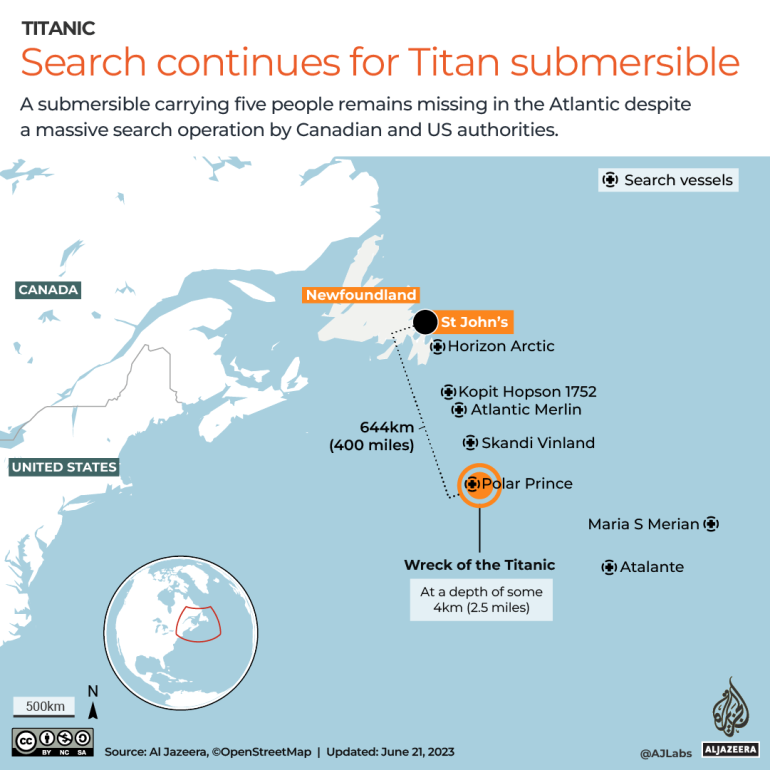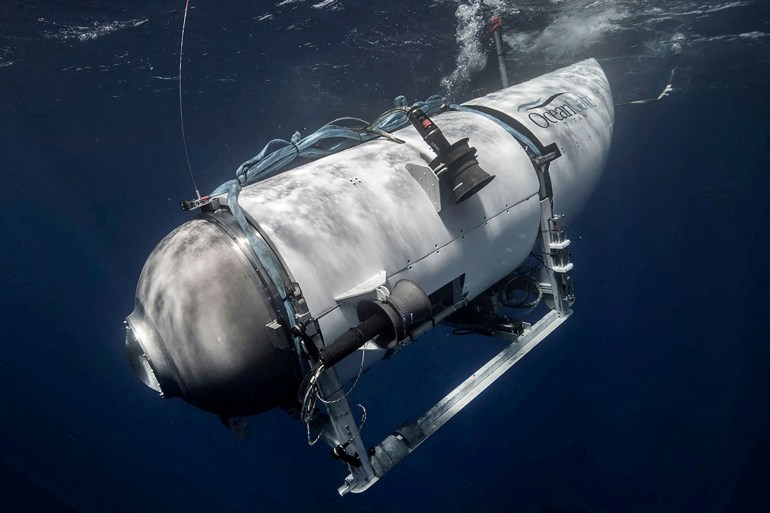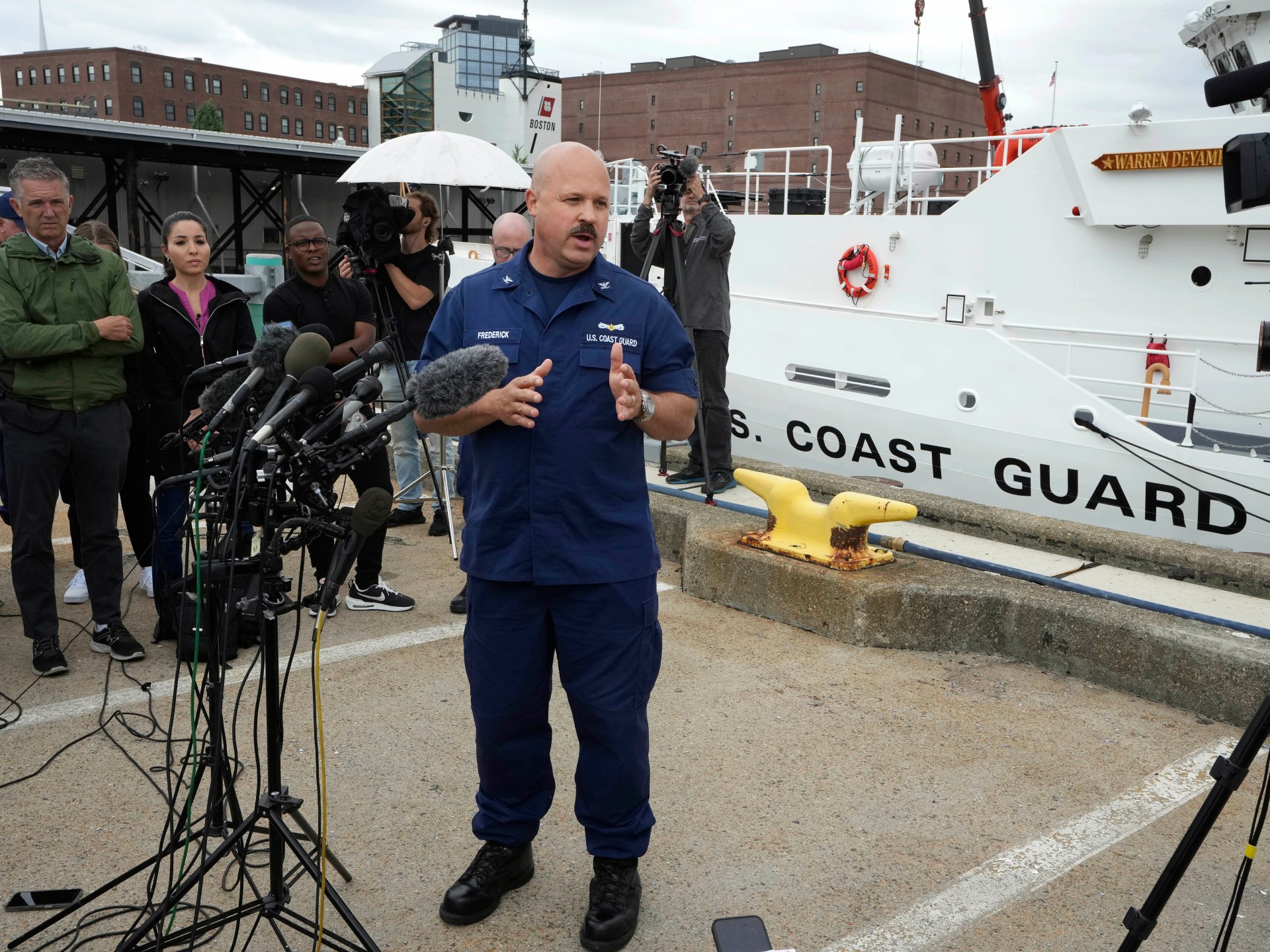A submersible vessel taking 5 vacationers on a deep ocean journey to view the wreckage of the Titanic went lacking on Sunday, triggering an infinite search and rescue effort.
Here’s a have a look at the scenario as rescuers race in opposition to time to go looking an space about half the dimensions of Belgium for the submersible, which could possibly be on the ocean ground or bobbing on the floor, with the vacationers bolted in from the skin.
On Tuesday at 17:00 GMT, consultants estimated the submersible had about 40 hours of breathable air left, which implies rescuers have somewhat greater than 20 hours to search out the lacking vessel.
Inhospitable terrain
If the submersible is on the ocean ground, it will be practically unimaginable to rescue, consultants say.
The Titanic wreck is about 2.5 miles (4 kilometres) under the floor. The submersible misplaced contact greater than midway down on its dive.
“It’s pitch black down there. It’s freezing chilly. The seabed is mud and it’s undulating. You’ll be able to’t see your hand in entrance of your face,” mentioned Tim Maltin, an knowledgeable on the Titanic’s sinking and wreckage.
Mike Reiss, a earlier Titan passenger, mentioned: “They could be caught on the backside of the ocean.
“Maybe there was a breach, and water got here in; I’m not very optimistic for his or her return,” he added.

Convey it up?
Specialists additionally say {that a} sub-to-sub rescue is unlikely from the underside of the ocean.
Solely a handful of submersible craft exist that would attain the depths of the Titanic wreck. Even when they may attain it, submersibles would not have the ability to tow the lacking vessel as much as the floor.
“We all know extra concerning the Moon floor than the underside of the ocean as a result of we simply haven’t surveyed it,” mentioned Jamie Pringle, a forensic geoscientist at Keele College in Britain.
Discovering it on the floor
Specialists say if the vessel is bobbing on the ocean’s floor, discovering it will likely be a needle-in-a-haystack scenario.
The vessel the dimensions of a van (size 6.7 metres and width 2.8 metres) will probably be even tougher to identify whether it is partially submerged. It’s far out within the ocean, so transferring ships and tools to the big space being searched takes time.
What has been performed thus far?
A minimum of 10,000 sq. miles (25,900 sq. kilometres) have been searched, in line with the US Coast Guard.
The Canadian analysis icebreaker Polar Prince, which was supporting the Titan, was conducting floor searches with assist from a Canadian Boeing P-8 Poseidon reconnaissance plane, and the Canadian army dropped sonar buoys to pay attention for any doable sounds from the Titan.
An underwater robotic had additionally began looking out within the neighborhood of the Titanic, and there was a push to get salvage tools to the scene in case the submersible is discovered, mentioned Jamie Frederick of the First Coast Guard District in Boston.
Two US Lockheed C-130 Hercules plane had been conducting overflights, and three C-17s from US Air Mobility Command have additionally been used to maneuver one other business firm’s submersible and assist tools from Buffalo, New York, to St John’s to assist within the search.
A Royal Canadian Navy ship that gives a medical workforce specialising in dive medication and a six-person cellular hyperbaric recompression chamber additionally was en route on Tuesday, in line with the Canadian army.
Canadian P-3 plane detected underwater noises within the search space. Because of this, ROV operations had been relocated in an try and discover the origin of the noises. These ROV searches have yielded detrimental outcomes however proceed. 1/2
— USCGNortheast (@USCGNortheast) June 21, 2023
The place did the Titan go lacking?
The crew of the Titan submersible misplaced contact with the crew of the Polar Prince analysis ship – an hour and 45 minutes after it started a dive to see the wreck on Sunday.
The wreck of the Titanic, a British ocean liner that struck an iceberg and sank on its maiden voyage in April 1912, lies about 900 miles (1,450km) east of Cape Cod, Massachusetts, and 435 miles (700km) south of St John’s, Newfoundland.
The Titanic sits on the ocean ground, about 4,000 metres (13,000 toes) under sea degree.
What’s the worst-case situation?
“The actual nightmarish situation is that they’re alive, on the floor … working out of air, and unable to get out,” David Pogue, science author and former Titan passenger, advised media.
Based on Jannicke Mikkelsen, a buddy of on-board businessman Hamish Harding and fellow explorer, the shortage of energy is likely one of the most important challenges.
The search is being performed from Boston.
“They’ve sufficient oxygen to maintain them alive and maintain them for 96 hours, however additionally they want energy to remain alive, so the worst-case situation is that they have oxygen, however they don’t have energy, and in the event that they don’t have energy they’re going to turn into hypothermic fairly shortly,” she mentioned.
Have been there any earlier warnings to OceanGate?
Years earlier than OceanGate’s submersible went lacking, the corporate confronted a number of warnings because it ready for its mission.
David Lochridge, OceanGate’s director of marine operations, wrote an engineering report in 2018 that mentioned the craft below improvement wanted extra testing and that passengers could be endangered when it reached “excessive depths,” in line with a lawsuit filed that yr in US District Court docket in Seattle.
OceanGate sued Lochridge that yr, accusing him of breaching a non-disclosure settlement, and he filed a counterclaim alleging that he was wrongfully fired for elevating questions on testing and security. The case settled on undisclosed phrases a number of months after it was filed.
Additional, OceanGate has mentioned the craft was designed to achieve depths of 4km (13,123 toes), the place the Titanic rested.
However, in line with Lochridge, the passenger viewport was solely licensed for depths of as much as 1,300 metres (4,265 toes), and OceanGate wouldn’t pay for the producer to construct a viewport licensed for 4,000 metres.

OceanGate additionally acquired one other warning in 2018, this one from the Marine Expertise Society, which describes itself as an expert group of ocean engineers, technologists, policymakers and educators.
The letter, reported by the New York Occasions, mentioned society members had been fearful that “the present experimental method adopted by OceanGate may end in detrimental outcomes (from minor to catastrophic) that will have critical penalties for everybody within the trade”. The US Coast Guard says a search protecting 10,000 sq. miles (26,000 sq. kilometres) has turned up no indicators of a lacking submersible.


